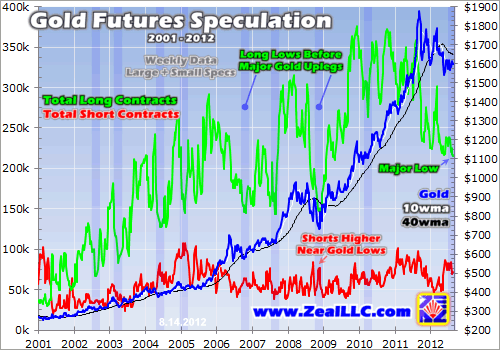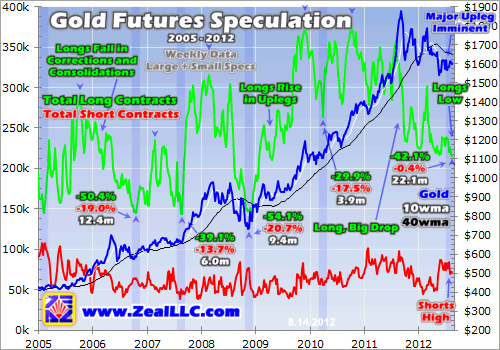Adam
Hamilton August 24, 2012
With gold awakening from its usual summer
slumber, traders are getting more excited about its prospects. Presumably
this shifting sentiment will even grow to encompass futures traders, who’ve
been incredibly bearish on the yellow metal for months now.
While traders
hold futures guys in high esteem, they are just as susceptible to groupthink as
everyone else. They are actually a powerful contrary indicator for gold.
Just a month ago, it seemed like you
couldn’t even give gold away. Bearishness abounded, and commentary and
analysis were overwhelmingly pessimistic and calling for major new lows
soon. Go back and skim the stuff published on gold in mid-July, and
you’ll quickly see what I mean. Because it had languished in a correction
since August 2011, shedding 18.8%, everyone was very negative on it.
Unfortunately this is typical in the markets,
as traders tend to mentally extrapolate short-term trends out into
infinity. When a price has been rallying for months, they assume it will
continue powering higher indefinitely. And when a price has been falling,
they convince themselves it will keep on grinding lower. These false
assumptions blind traders, rendering them incapable of buying low and
selling high.
Peer pressure feeds in as well, as traders
feel very uncomfortable being bullish when everyone else is bearish and vice
versa. There is comfort in the crowd’s warm embrace, running with the
herd to ensure acceptance. Succumbing to this groupthink is the main
reason the great majority of traders lose money. They don’t buy until
everyone is bullish, which only happens after prices have already run
high.
And after buying high, a fool’s errand,
they get frightened into selling when everyone is bearish. Of course that
only happens after prices have already seriously sold off. Buying
high and selling low is not the recipe for building a fortune, but for
financial ruin. And amazingly even the large majority of futures traders,
with all their alleged sophistication, stumble into this deadly trading
trap. They run with the herd.
Contrarianism is the only remedy for
groupthink, being brave when everyone else is afraid and vice versa. The
best time to buy low is when no one else wants to buy, and the best time to
sell high is when everyone else wants to buy. This is simple in concept,
but incredibly difficult psychologically in execution. It takes many
years of trading experience, and an iron will, to actively fight the herd.
I know how brutally hard contrarianism is
because I’ve painfully forged myself into one over decades. Back in
mid-July when the trading world was so darned bearish on gold, I was
bullish. I wrote an essay then explaining that the summer doldrums leading to
major seasonal lows that time of year were par for the course for this entire
secular gold bull. These lows soon yield to gold’s major autumn rally, which
is indeed now underway.
As a group, futures traders didn’t expect
this upside move even though gold does it almost every year like
clockwork. There are as few contrarians per capita in the futures world
as there are in any other pool of traders. How can I dare make such a
heretical assertion? Futures traders’ biases are laid bare in the
Commodity Futures Trading Commission’s giant Commitments of Traders report,
published weekly.
If you are not up to speed on the CoT, I
wrote an essay
explaining how bullish it was for gold a month ago when pessimism still dominated.
In gold and many other futures markets, the CoT reveals how many futures
contracts are open at any given time, which group of traders holds them, and
whether these groups are taking the long side or short side of the trade.
This last datastream reveals futures traders’ sentiment.
The only time traders will make long-side
bets on something is when they expect its price to rise. So playing the
long side indicates bullishness. And it is only rational to sell futures
short when traders expect their underlying price to fall. So shorts show
bearishness. And incredibly in the entire history of gold’s spectacular
secular bull over the past decade or so, futures traders are the least long
right before major uplegs get underway!
Of course futures are a zero-sum game,
every single contract has a trader on its long side with a different trader
taking the opposite short side. The only way to make money in futures is
if your counterparty loses it. Capital merely changes hands, it isn’t
created or destroyed like in the stock markets. But while longs and
shorts are always perfectly balanced, they flow and ebb among the major categories
of traders.
The CFTC essentially divides futures
traders into two categories, hedgers and speculators. Hedgers are
formally known as commercials in the CoT, and are large traders who are
actively involved in either physically producing or consuming the underlying
commodity. In the gold world, this includes miners on the production end
and jewelers on the consumption end. Hedging is why futures markets exist
in the first place.
But hedgers can only hedge because
speculators are willing to take on the risks the hedgers want to offload in
order to smooth their operating cashflows. The CFTC farther divides
speculators into two sub-categories, large speculators and small
speculators. These are formally known as non-commercials and non-reportables
in the CoT reports. And it is these speculators, large and small alike,
that are contrary indicators for gold.
In my usual CoT analysis thread, I look
at net long and short positions held by each category of traders.
That is the most logical strategic approach in a zero-sum game where total longs
and total shorts are always perfectly equal. But this week we’re digging
deeper, looking at the total long-side gold futures contracts held by
both large and small speculators. These vaunted traders are victims of
some serious groupthink.
Our charts superimpose gold over the weekly
CoT data of total spec longs (green) and total spec shorts (red). As
you’ll see, the futures traders are always wrong near major lows in gold
before massive uplegs. Since the great majority of them aren’t
contrarians, they give up on gold after corrections or long
consolidations. But that is exactly when gold is the cheapest and ready
to start surging higher again.
Trading is all about buying low and selling
high, so if gold futures traders were prudent contrarians you’d expect them to
be the most bullish right before major uplegs. But this hasn’t
been the case. For gold’s entire secular bull, a gargantuan 638% run higher
over a decade, futures traders as a group haven’t been able to get this
right. As this chart shows, speculator longs in gold futures hit major
lows near gold lows just before major uplegs.
The green line shows the total long
positions held by large and small speculators per the CoT reports. I
highlighted major lows in this series over the years with light-blue
columns. Before today, there were 8 major lows in speculators’ total
longs. Look at gold’s performance after each of them. Every
single time the metal soon started rallying, usually enjoying one of this
bull’s super-profitable massive uplegs.
While total longs coincide with low gold
prices before major surges, notice where the light-blue columns hit the red
total-shorts series. Speculators’ short positions in this metal tend to
be at highs, near highs, or at least on the high side of their secular trading
range every time gold is cheap and poised for a major advance. Futures
traders are truly not contrarians, so the smart thing to do is make the
opposite bet from what they are making!
For my entire trading life, over a quarter
of a century, I’ve constantly heard variations on the theme that futures
traders are smart while stock traders are dumb. And though I’m certainly
biased on this question as a lifelong stock trader, this oft-voiced aphorism
simply isn’t correct. True contrarians, battle-hardened traders who walk
the walk in fighting the crowd, are as rare in the futures world as they are in
the stock markets.
When speculators’ total long positions in
gold futures collapse to major lows, there has literally been a 100% chance
throughout this entire secular bull that gold is right on the verge of surging
higher. You’d be hard-pressed to find a better strategic contrarian indicator
than the biases of gold futures traders. And this brings us to the reason
why I wrote this essay this week, a major new low in total spec longs today.
Before gold’s recent major correction, it
topped just under $1900 in August 2011. As an actual contrarian, I wrote
an essay one trading day before this top warning that gold was very overbought so a sharp
correction was imminent. Believe me, it is never easy fighting the
crowd. Whenever I make a contrary call like that, getting bearish while
everyone else is euphoric, I get raked over the coals with scorn.
But in the timeless words of a 1990s
alt-rock song, “[bleep] the naysayers cause they don’t mean a thing”. In
the markets capital flows away from the mainstreamers who get greedy at highs
and scared at lows to contrarians. We grow rich while those who
can’t fight groupthink slowly bleed away their fortunes. The subsequent
gold correction carved a decisive low in mid-May, during a full-blown capitulation.
Around that week gold bottomed, total spec
longs fell to 216.0k contracts. In late May they slumped again to
217.3k. Then after recovering a bit as gold bounced in early June, they
fell to 220.1k at gold’s major seasonal low in late July. In early
August’s CoT, they retreated again to 218.2k. But amazingly in the most
recent CoT as of this writing, with August 14th data, total spec longs in gold
futures fell to a new low of 215.5k!
To put this into perspective, gold spec
longs haven’t been this low since April 2009 just after the stock panic’s
secondary low. Gold was trading near $880 that week! How did it do
since? Pretty freaking awesome, as you can see on the charts.
Futures speculators, as evidenced by their lack of longs in the latest CoT, are
as bearish on gold today as they were just before it more than doubled
in a massive multi-year run!
They’ve been wrong as a group before every
other major upleg in this entire secular gold bull, and I’m betting big money
that they are wrong again today. Traders who are not contrarians, who get
afraid when everyone else is scared, are going to fail. Succumbing to
popular fear always leads to both selling low and failing to buy low.
And futures traders are as bearish on gold now as they’ve been in several
years.
This next chart zooms in a bit to examine
the huge drop off in futures-speculator enthusiasm for gold when this metal is
consolidating or correcting. The same major long lows highlighted above
are highlighted here as well. I was interested in the total drops in spec
longs from the preceding highs before these lows. They are shown in
green, with the corresponding spec-short drop in red, along with how long these
declines took.
Since futures speculators aren’t
contrarians, their long bets rise during gold uplegs and contract during gold
consolidations and corrections. I suspect that the magnitude of these
contractions reflects the degree that sentiment shifts among these
traders. So the bigger the drop off, the more pessimism exists on gold and
therefore the higher it is likely to run. The greatest example of this
was 2008’s stock panic...Read more>>

